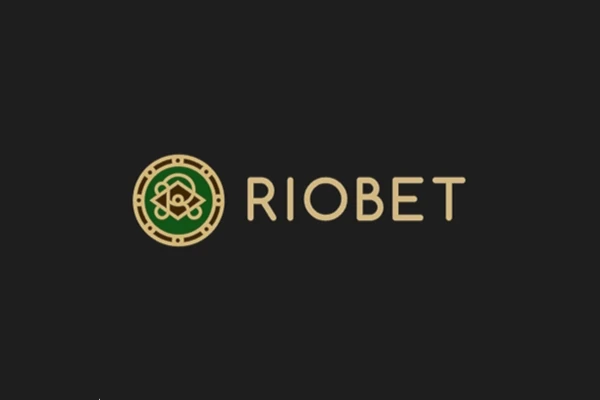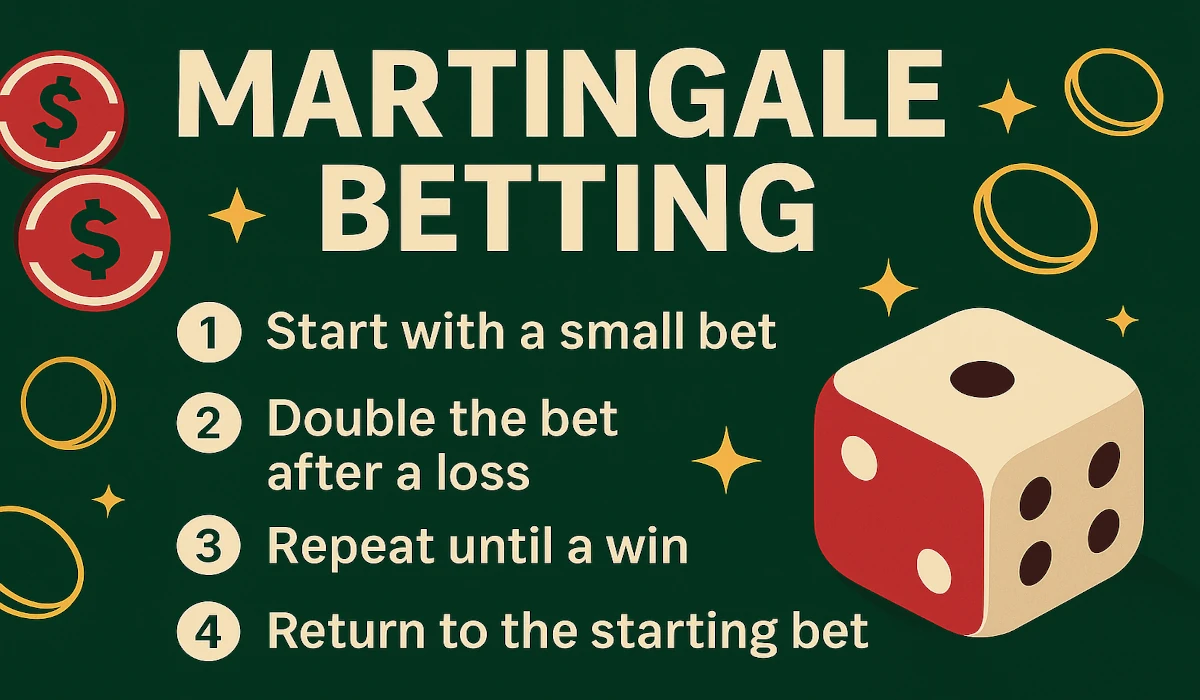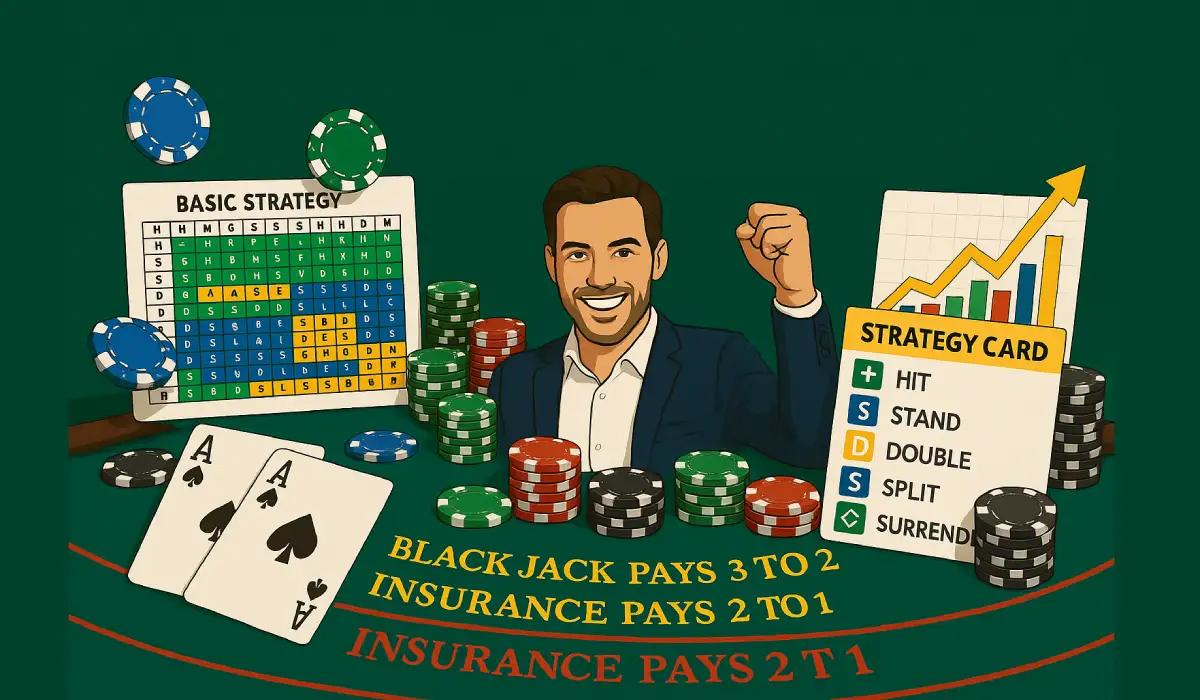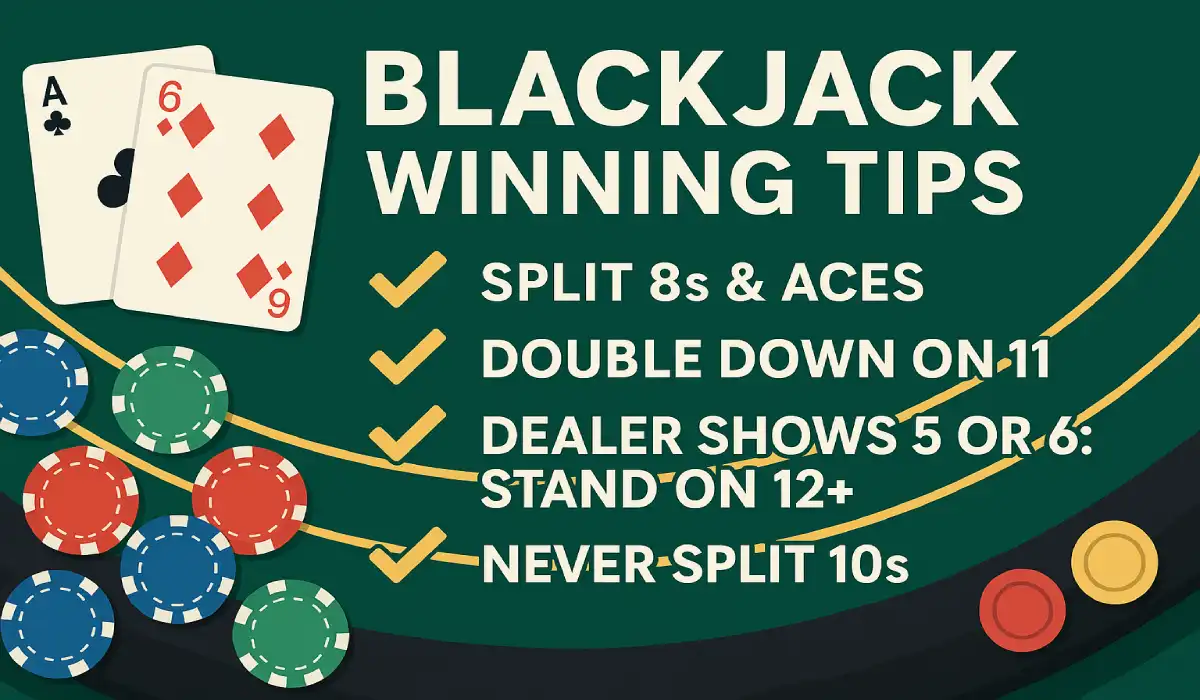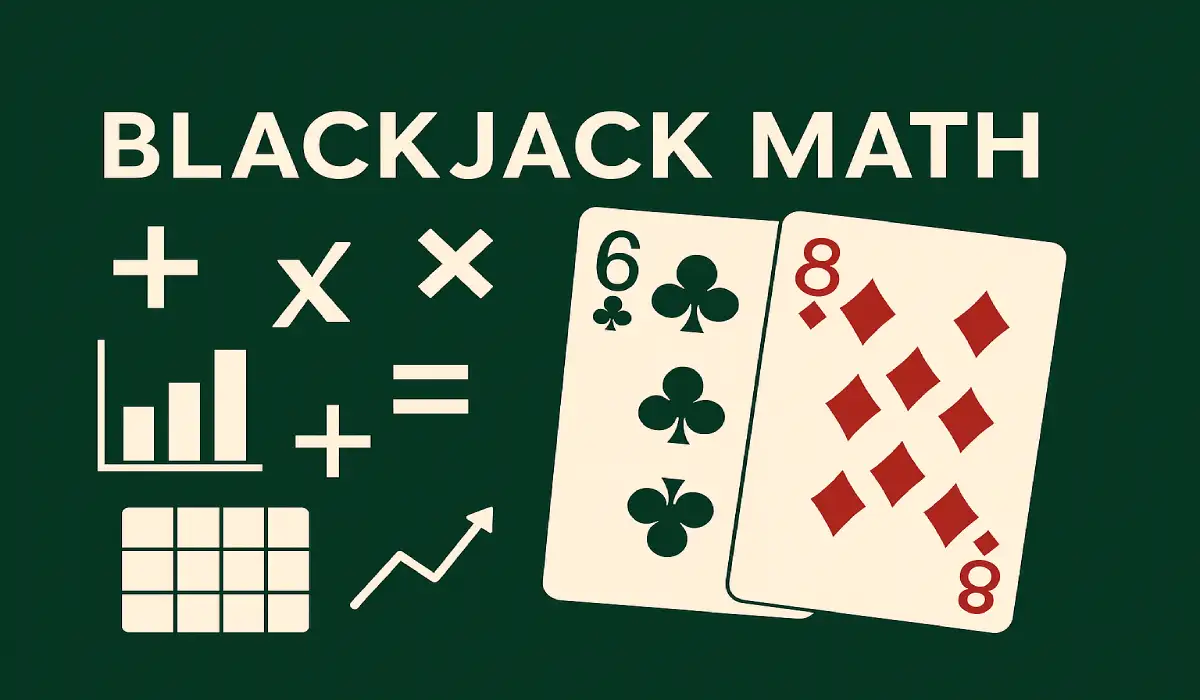
18 Jun 2025
Blackjack Math: Mastering the Mathematics Behind Your Strategy
🗝️ Key Takeaways
- By mastering blackjack math, you'll be prepared to make every strategic decision like a pro, whether you're on the casino floor or at the blackjack table for the first time.
- With probability, expected value and hand combination calculations, players can quantify risk and pinpoint the best move on the fly, so that every step is statistically warranted.
- Knowing the house edge, and how rules variations impact it, gives players the ability to pick games and strategies that limit their long-run losses, no matter what casino or online venue they visit.
- Basic strategy charts, good bankroll management, and steering clear of obvious math fallacies allow for consistent, disciplined play — and keep emotions in check.
- Card counting, simulation modeling, and other advanced techniques can further boost players' edge. It is essential to recognize their real-world constraints and ethical implications across different gaming contexts.
- By busting myths and centering on math instead of magic, you keep your game rooted in reality, which is a winning strategy for players everywhere.
Blackjack math = how numbers and odds influence blackjack. Card values, deck counts, and probability dictate every round and decision at the table.
Clear-cut mathematical reasoning explains why certain plays are superior, such as when to hit or stand. Understanding the mathematics of blackjack gets them to play more intelligently and reduce the house advantage.
The following chapters drill down on the key concepts and demonstrate concrete applications of these principles.
🎲 What is Blackjack Mathematics?
Blackjack math is crucial for understanding the blackjack strategy guide at the table, as it involves using numbers to make savvy decisions. Each action, whether hitting or standing, is based on your chances of winning or losing, which ties into the optimal blackjack strategy.
Familiarity with these figures, including probability and expected value, allows you to play smarter, reduce the house advantage, and form tougher tactics for any table size or deck amount. Knowing the common blackjack terms and terminologies also helps when following advanced guides or consulting a quick cheat sheet during practice.
1. Core Probability
In blackjack, understanding the blackjack odds begins with grasping the probability of drawing specific cards. For instance, in a single deck game, the odds of getting an ace are 4/52, roughly 7.7%.
If you require a 10-value card (10, J, Q, K), that’s 16 of 52 or about 30.8%. These odds fluctuate as cards are dealt, especially in blackjack games with fewer decks.
It’s not just about the cards; knowing your odds of making 21, busting, or ending up with a weak hand is essential. For example, if you’re sitting on a 12, the probability of busting on a ten-value card is 16/49 (after two cards dealt), which is approximately 32.7%.
Blackjack players utilize this information to determine the optimal strategy for when to hit or stand.
To help, here’s a list of common probabilities (single deck, after initial deal):
• Drawing an ace: ~7.7%
• Drawing a ten-value card: ~30.8%
• Busting with 12: ~32.7%
• Busting with 16: ~61.5%
2. Expected Value
Expected value (EV) means how much, on average, you should expect to win or lose by making a certain move. In blackjack, every decision—hit, stand, double down in blackjack, split—has its own EV, depending on the cards in play.
Let’s say, for example, hitting on 16 versus a dealer’s 10. The EV could be negative because the bust odds are high. Contrast that withstanding, which similarly has a negative EV, but usually not by as much.
Players ought to select the action with the greatest EV over time to minimize losses.
A sample chart (simplified, single deck):
| Action | EV (Dealer 10 Upcard) |
| Stand 16 | -0.54 |
| Hit 16 | -0.54 |
| Double 11 | +0.67 |
3. Hand Combinations
Numerous combinations to make various blackjack totals. You can reach 21 with Ace-10, or with 3 or more cards such as 7-7-7.
When it comes to a particular hand, the odds of getting them are contingent on the cards still in the deck.
Familiarity with these combos aids you in estimating your chances versus the dealer. For instance, if you’ve got 12 and the dealer’s up card is a 6, standing is frequently best since the dealer should bust quite a bit.
Knowing when to split aces is also critical to leverage hand value in your favor. With additional decks, the math shifts a little, but the main principles remain.
A quick table for hand totals (single deck, after two cards):
| Total | Combos |
| 21 | 4 |
| 20 | 16 |
| 19 | 12 |
4. Bust Likelihood
Bust probability is important whenever you hit. With 13, the chances of busting are slim, but with 16, they’re much greater.
- Bust chance with 12: ~31%
- Bust chance with 16: ~62%
- Bust chance with 18: ~77%
- Bust chance with 20: ~92%
This bust guide speeds up your choices.
5. Dealer's Odds
The dealer’s up-card is a game-changer. If the dealer shows a 6, their bust chance is as high as 42%.
With an ace, it plummets. Armed with this knowledge, you modify your play—hit more when the dealer is strong, stand more when the dealer is weak.
Deciding when to buy blackjack insurance can also be influenced by the dealer’s up-card strength.
A quick chart:
| Dealer Upcard | Bust % |
| 2 | 35% |
| 6 | 42% |
| Ace | 17% |
🎰 The House Edge Reality
Each blackjack game features a built-in house advantage, commonly referred to as the house edge, which is crucial for understanding blackjack odds. This edge is why casinos profit over time, even when players achieve a blackjack win.
The house edge in blackjack can be as low as 0.39% with optimal strategy, but it can rise to 2% or more with poor play or unfavorable rules. Understanding how this edge operates and the factors that influence it is essential for players aiming to make informed bets and minimize losses.
🎯 Why It Exists
The house edge in blackjack games exists because casinos establish rules and payout rates that skew the odds in their favor, even if just a little. For instance, the dealer always goes after the player, so if both bust, the player loses.
Payouts like 6:5 for blackjack, instead of the classic 3:2, further increase the house’s take. A player who follows basic strategy, i.e., employs the optimal blackjack strategy, can maintain the edge low – often less than 0.5%.
If you deviate from this, the edge increases quickly. For context, European roulette has a 2.7% house edge, significantly larger than blackjack.
This edge resembles having a one in three chance to win a bet, with the house ‘taking’ one of every three bets in the long run.
Factors that affect the house edge:
- Table rules (dealer stands/hits on s17).
- Blackjack payout rates.
- Decks.
- Surrender and doubling choices.
- Player strategy.
🔥 Rule Variations
Rule changes can significantly affect your expected value in blackjack games. For instance, if a game pays only 6:5 on blackjack payouts, the house edge increases by over 1%.
Certain games allow you to double down in blackjack after a split, benefiting the player and reducing the edge. Additionally, games that use several decks can slightly increase the house advantage.
Even minor differences, like the dealer hitting or standing on soft 17, can tilt the odds in favor of the house.
| Blackjack Variant | House Edge (%) |
| European Blackjack | 0.39 |
| American Blackjack | 0.61 |
| Blackjack Switch | 0.58 |
| Video Blackjack | 0.5–2.0 |
| Live Dealer Blackjack | 0.49–0.72 |
| Free Bet Blackjack | 1.0 |
| Face Up 21 | 0.85 |
💥 Your Impact
How you play affects your outcome more than you might think. Basic strategy play isn’t a choice if you desire the most favorable odds – it’s the only way to maintain the lowest house edge possible.
Little errors, like splitting tens or taking insurance, can accumulate and end up costing you more than you bargained for. Your bankroll management is important, too.
You are able to control how much that edge impacts you over time by walking away after large wins or setting loss limits.
A good checklist for play:
- Learn and use basic strategy.
- Avoid side bets and insurance.
- Choose tables with player-friendly rules.
- Track wins and losses to avoid tilt.
🚀 Advanced Mathematical Applications
Blackjack provides a rare example of a situation in which math can change the odds. Players can deploy sophisticated blackjack strategies that transcend simple strategy, seeking to push the house edge in their direction.
Techniques like card counting, simulation, and deck composition provide real-world tools for players willing to dig deeper. These concepts borrow from mathematics and statistics, providing blackjack players with strategies to evaluate and decide with greater understanding.
♠️ Card Counting
Card counting is a method of monitoring what cards have been dealt and remain in blackjack games. By maintaining a simple or complex count, a player can estimate when the deck is rich in high cards, such as tens and aces, which benefit the player's blackjack strategy.
This aids in making the bets with the greatest likelihood of getting blackjack or pushing the dealer to bust.
There are multiple systems available for this purpose. The Hi-Lo system is particularly popular among blackjack players. It values +1 on low cards (2–6), 0 on neutral cards (7–9), and –1 on high cards (10–A).
Players maintain a running count and then vary their bets as the count increases. More robust systems, such as Omega II or Wong Halves, assign more weight to certain cards, but they can be tricky to use during rapid play.
These systems provide a more precise strategy but require additional practice.
Casinos don’t like card counters. Although not unlawful, casinos frequently ban or refuse service to suspected counters.
Players need to balance the ethical and legal risks prior to employing such tactics. In some locations, employing peripherals or co-op can be illegal.
A basic step-by-step guide to card counting: Start by assigning values to each card. Maintain a cumulative tally as cards are distributed.
Calculate the true count by taking the running count and dividing it by the number of decks still left in the shoe. Modify bets and playing strategy according to the true count.
📊 Deck Composition
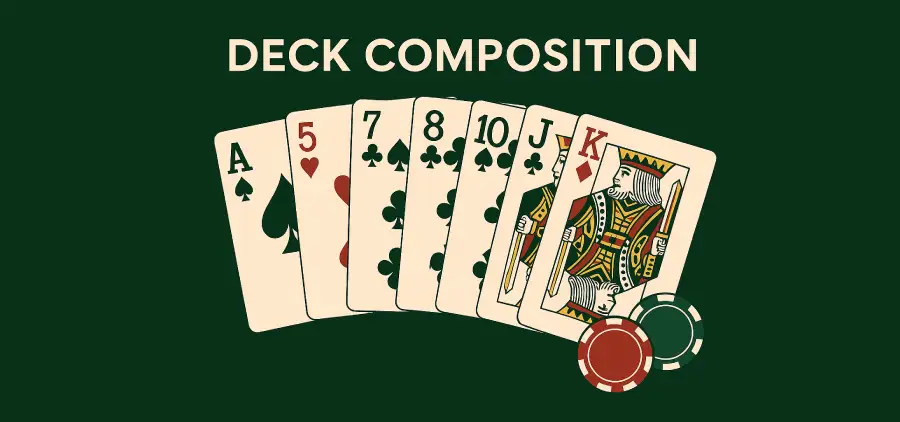
Deck composition is about what cards remain in the shoe. If there are a lot of high cards left, then the player is better off, so the strategy should be different.
In six or more deck games, composition tracking is trickier but not impossible.
To estimate the probability of pulling out a specific card, tally how many are left after each hand. Now, divide that by the number of cards remaining in the deck.
For instance, if the four aces are still in play and there are 50 cards remaining, the probability of an ace is 4/50.
As the deck shifts, so do the optimal plays. If a lot of low cards are out, a player can stand more because the dealer will probably bust. Charting deck composition involves creating an easy grid or tally sheet to indicate which cards have been used.
Following variation assists to be aware of betting bigger or smaller. It works best when the casino employs fewer decks or shuffles less frequently.
💻 Simulation Models
Simulation models test strategies by using computer programs to run thousands of hands. Such models can demonstrate the long-term consequences and expected value of each move, allowing players to visualize which decisions yield the best rewards.
Simulations can record volatility—the rollercoaster-like swings in a player’s bankroll. By observing how various strategies fare across numerous situations, players can select the tactic that matches their risk tolerance.
For example, a simulation could reveal that reckless betting raises the expected win but raises the risk of going broke fast. To construct a stupid model, you enumerate the rules, you code up the basic strategy, you run multiple hands with random draws.
Record victories and defeats and the tally to observe which techniques accumulate gain.
📋 List of Advanced Techniques
- Card counting (Hi-Lo, Omega II, Wong Halves).
- Deck composition tracking.
- Simulation modeling.
- Shuffle tracking.
- Expected value analysis.
- Volatility assessment.
⚡ Debunking Common Math Myths
Most players assume blackjack is merely a game of chance, but studies and experience demonstrate that it’s a casino banking game governed by mathematics, skill, and optimal strategy. Bad information makes for bad decisions and wasted cash. Understanding the blackjack rules will help you skip the traps and play savvy.
🎭 The "Due" Fallacy
Many players believe that a particular result is “owed” after a string of losses, that the next hand is due to win. We call this the ‘due’ fallacy. In reality, each hand is autonomous.
Cards have no memory of the past. This myth makes players place larger bets, believing they are due to win. Contemporary casinos are equipped with automatic shufflers or multiple decks, so no card is obligated to show up.
Trusting this myth gets you deeper into the hole, not out of it.
Instead, employ probability, not superstition. Results are arbitrary, and no pattern guarantees a victory.
It’s better to stick with something like basic strategy charts. If you begin to sense a victory is due, stop and remember that every hand is a coin flip–nothing is certain. Don’t chase losses on what you believe should occur.
🍀 Dealer's "Lucky" Card

Some think specific dealer cards, like an ace or face card, are “luckier” than others and destined to beat you. In truth, every hand is a fresh occurrence. Dealer cards have no memory of past results.
Contemporary games employ RNGs or continuous shuffling to ensure fairness and randomness.
The wiser strategy is to concentrate on your own moves—your decisions are far more influential than predicting the dealer’s “luck”. If you want to keep your game on track, build a checklist: always use basic strategy, never bet based on “hot” or “cold” streaks, and ignore superstitions about dealer cards.
🎩 Mimicking The Dealer
Imitating the dealer—hit under 17, stand over—makes sense, but it’s mathematically incorrect. The dealer plays strict house rules to maintain the edge, players make decisions and have options.
If you imitate the dealer, you lose player benefits like doubling down, splitting, or surrendering. The math rewards innovative, tactical action, not mechanical mimicry.
Players who remain committed to optimal strategies have longer-term success. As an illustration, the Martingale betting system appears infallible yet falters in reality because of table maximums and finite bankrolls.
Card counting, while complicated, demonstrates how expertise and strategy can shift the probabilities. Luck is a factor—excellent players go on losing streaks for weeks, but in the long run, their talent comes through.
💥 Common Myths vs. Facts
- Myth: Blackjack is pure luck.
- Fact: Skill, strategy, and math play a strong role.
- Myth: Martingale guarantees wins.
- Fact: Table limits and bankrolls make it risky.
- Myth: Dealer cards are luckier.
- Fact: Dealer hands are statistically random.
- Myth: Mimic the dealer to win.
- Fact: Player strategy offers more options and better odds.
🔒 Conclusion
Blackjack operates on transparent mathematics. Every hand has a narrative with genuine probabilities.
The house edge never slinks. Basic strategy provides a robust foundation, and the math supporting it remains simple yet incisive.
Players armed with math tools, such as card counting, view the game differently. Myths crumble when you examine the blackjack math.
Every decision at the table demonstrates what the math translates to for your chips. Truth trumps fortune every time.
To improve, continue to question and experiment. Email your own tips or tales to our crew.
Develop your abilities alongside us, and let the figures do the guiding.
Frequently Asked Questions❓
What is the house edge in blackjack?
The house edge in blackjack games represents the casino’s inherent advantage. With normal blackjack rules and basic strategy, this edge is typically around 0.5%, meaning the casino wins 0.5 for every 100 bet.
How does basic strategy use math in blackjack?
Basic strategy leverages probability and statistics to direct every move in blackjack games. It informs players when to hit, stand, split, or double down, enhancing their chances of a blackjack win based on pure math.
Can you really beat blackjack with math?
Yes, with math-driven approaches such as basic strategy and optimal blackjack strategy, you can minimize the house advantage. To beat blackjack games consistently takes skill, discipline, and careful play.
What is card counting and is it legal?
Card counting is a mathematical study strategy that helps blackjack players keep tabs on high and low cards played, assisting in calculating the player's edge in blackjack games. It is perfectly legal, but casinos can deny counters service.
How do you calculate your advantage in blackjack?
To figure your edge in blackjack games, use fundamental strategy and count the cards. If there are more high cards left, you’re more likely to win, making it essential for blackjack players to gauge this advantage as it occurs.
Are there common math myths about blackjack?
Yes, many blackjack players believe that previous results influence the upcoming hand. In reality, each hand is independent unless you employ a card counting strategy. Another misconception is that success in blackjack games relies solely on luck, when in fact, blackjack strategy and math are crucial.
Does using mathematical strategies guarantee winning at blackjack?
No, not even the greatest blackjack strategies can eradicate the house edge altogether. They just reduce it. Short-term outcomes in blackjack games are all over the place, but in time, playing by the math gives you the best shot.
